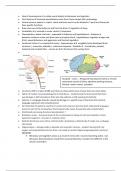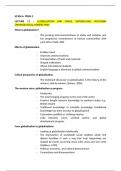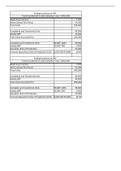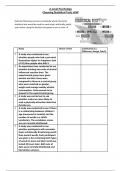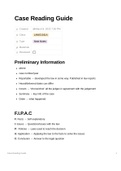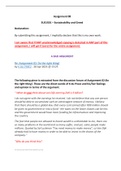• Goal of neuroscience is to relate neural activity to behaviour and cognition
• First theories of funcional specialisation came from Franze Joseph Gall- phrenology
• Central nervous system is a spine chord and brain and it can be divided in 7 parts and these part
have specific functions
• Brain stem send information to and from the brain ?/ regulation of sleep
• Cerebellum it is involved in motor control / movement
• Diencephalon- above mid brain , separated in thalamus and hypothalamus , thalamus is
between cerebrum cortex and brain stem and spinal chord , hypothalamus regulates hunger and
thirst, sexual behaviour and aggression and thermal regulation
• Cerebrum cortex it is composed of cortex , hippocampus and amygdala (most developed brain
structure ) , memories, attention , instinctual response . Dividedin 4 – frontal lobe, parietal,
temporal and occipital lobe - names are from the bones that overlay them
•
Occipital – vision , Tempporal-hearing and memory ,Frontal-
movement control of limbs, attention,working memory ,
Parietal- motor control, sensation
• Functional MRI is a type of MRI scan that can show which areas of your brain are most active
• Father of modern neuropsyhology Pierre Paul Broca – studied stroke he discovered that there
was damage in left hemisphere thats why the patiente couldt speak grammatically
• Aphasia is a language disorder caused by damage in a specific area of the brain that controls
language expression and comprehension
• Karl Wernicke his patients could form words and sentences but they dont understand language (
posterior part of the cortexwhere the temporal lobe meets the parietal and occipital lobe)
• Distributed processing-funcional specialisation ?
• Brodmann areas – funcional areas of the cortex based on shape of cells and variation in their
layered arrangment , 52 areas in cerebral cortex
• Razliciti deo brocas area radi za razlicite jezike i prekrstaju se delovbi ako ih ranije ucis a odvajaju
ako kasnije
• Hippocampus – damage leads to episodic and semantic memory , problem during birth npr.
oxygen not being delivered to the brain can leaad to smaller hippocamppus(episodic memory)
NEURONS
➢ Behaviour and cognition arises as a result of nerve cells- neurons becoming active , but
behaviour diversity doesnt result from neuronal diversity it results from different in the
neuron connection
, ➢ Glial cells – most abundant in central nervous system, no dendrites and axons and not
inovlved in neuronal signaling , microglia and macroglia-> schwann cells(cns),
oligodendrocytes (pns) and astrocyte( separatte neurons, release growth factors,
connects to blood vessels) , also make myelin sheets( schwann and oligod) and help in
brain injury
➢ Neurons : cell body , dendrites( receive signal) , axon and pre synaptic terminals (
pogledaj papirr iz human)
➢ Action potentials are signals that allow the brain to receive, analyse and convey
information , its all or nothing event
➢ myelin sheath allows electrical impulses to transmit quickly and efficiently along the
nerve cells
➢ Camilo Golgi- neuron visualisaton with staining
➢ Ramon Cajal identified 2 organisinf prinicples of neurons 1. Electrical signal travel in one
direction 2. Neurons dont connect at random with other neurons , 3 types of neurons –
unipolar,( singal primary process) bipolar( 2 processes axon and dendrites) and
multipolar ( single axon and multiple dendrites )
➢ Sensory cells are bipolar in the retina and olfactory epithelium
➢ Neurons conveying information about touch,pain and pressure are pseudounipolar cells
MEMBRANE POTENTIAL MECHANISMS AND FUNCIONS
• Cellular membrane is referred to as the bilipid membrane because it has phospholipids – they
have hydrophilic head and hydrophobic tails
• Surounds all cells and some organelles , high degree of fluidity , self assembling and healing ,
the membrane is impermeable for polar and charged patricles -ions
• Bilipid membrane function is to prevent diffusion of cellular organelles and control influx and
efflux of various substance . It has ability to maintain voltage difference between outside and
inside .
• Plasma membrane acts as a capacitor charges can accumulate on both sides, but not pass
through
• Transmembrane Voltage (Vm ) functions as an energy store for cellular processes, e.g. transport
across membrane the basis for neuronal computation (via summation of voltages from different
synapses) the basis for neuronal communication (via transmission of voltage fluctuations,
socalled action potential
• Voltage= difference in electric potential the greater the voltage the greater the current , more
resistance less can flow and lower the resistance more current can flow more proteins and
chanelss you have lower the resistance
• Measuring the membrane potential - Microelectrode inserted into the cell (very small tip, ~1um)
Reference electrode outside the cell (also small), Precise voltage recorder (uV to mV rang
• Resting potential is the potention at which the membrane sits , the resting potential of neurons
is about -70 mV/ when chemical potential and electrical potential matchet / negative inside ,
positive outside
,• The patch clamp technique is a laboratory technique in electrophysiology used to study ionic
currents in individual isolated living cells, tissue sections, or patches of cell membrane,
measurement is in vitro/in vivio . It gives you both electrical and chemical access
• Intra and extracellular fluids contain different amont of ions, ions are molecule with positive or
negative charge . Most important ions for neurons are sodium (Na), potassium (K), Chloride (Cl) ,
Calcium (Ca) , proteins (A)
• If there is an equal number of charge on the inside and outside of the cell then the membrane
potential is 0, if it is unequal then it is different from 0. If there is more negative inside then the
membrane potential is smaller then 0
• Membrane potential is a local charged separation
• Majority of the intra and extracellular fluid is charged balanced
• ION PUMP- Na and K pump and it one step it transport 3 Na out and 2 Ka in this transport
required constant use of ATP = Na 150mM outside and 15mM inside , K 5mM outised and 150
mM inside
• Chemical potential is present if concentration differ across the membrane , diffusion can equal
them
• Electrical potential is given by the voltage across the mebrane and this voltage can influence the
ion flow
• If chemical and electrical potential matched there is no net flow
• ION CHANNELS- passages through the membrane they are made of multiple subunits , they only
allow particles to pass through
• Variations of channels - selectivitiy for particular ions , constantly open ones , gateable channels
or voltage sensitive
• NERNST EQUATION - relation between chemical and electrical potential , chemical potential –
concentration inside and outside and electrical potential- voltage Vm across the membrane
➢ Factors that determine the relation – temperature (T) , higher
the temperature more diffusive particle motion , ion charge –
higher the charge less volts needed peer ion to oppose the
diffusion
➢ R- ideal gas
➢
, ➢ F- faraday constant \
➢ E- Nernst potential tells us
how much voltage you need
to oppose the chemical
gradient
• Potassium concentration is
established by Na/K pump , the K
channels are open and they can flow and create local unbalanced charges
• Sodium leak channels further enhancing the influx of sodium ions, while potassium leak
• channels allow potassium ions to diffuse out of the cell. It doesn't matter if the neuron is at the
resting membrane potential, depolarizing, repolarizing, or hyperpolarizing; the leak channels are
always open
• Equivalent circuits = capacitor , voltage sources – reversal potential of each ion , conductance-
selective ion channels
• More pitasium leaks channels then sodium
• Layer V pyramidal cell
• Changes in membrane potential can carry information – rapid brief changes , transmit
information , communication between and within the cell , speed up action and reaction , sum
the input from many sources
• Steps in neural computation
1. Integration of input potential
2. Creation of an action potential
3. Conduction of the action potential
4. Transmission to another neuron via Synapses
• Inhibitory input leads to hyperpolarization and if you get excitation
input you get depolarization
•
•
• Stimulating a neuron means providing an input you introduce a current to the cell and they a
membrane begins to accumulate charge and this is changing a membrane potential
• Spreading of membrane potential along the cell membrane - locally injected current spreads
away from the injected site and the current charges the neighbouring parts of the membrane
and then the current depolarazises the neighbouring membrane
• First theories of funcional specialisation came from Franze Joseph Gall- phrenology
• Central nervous system is a spine chord and brain and it can be divided in 7 parts and these part
have specific functions
• Brain stem send information to and from the brain ?/ regulation of sleep
• Cerebellum it is involved in motor control / movement
• Diencephalon- above mid brain , separated in thalamus and hypothalamus , thalamus is
between cerebrum cortex and brain stem and spinal chord , hypothalamus regulates hunger and
thirst, sexual behaviour and aggression and thermal regulation
• Cerebrum cortex it is composed of cortex , hippocampus and amygdala (most developed brain
structure ) , memories, attention , instinctual response . Dividedin 4 – frontal lobe, parietal,
temporal and occipital lobe - names are from the bones that overlay them
•
Occipital – vision , Tempporal-hearing and memory ,Frontal-
movement control of limbs, attention,working memory ,
Parietal- motor control, sensation
• Functional MRI is a type of MRI scan that can show which areas of your brain are most active
• Father of modern neuropsyhology Pierre Paul Broca – studied stroke he discovered that there
was damage in left hemisphere thats why the patiente couldt speak grammatically
• Aphasia is a language disorder caused by damage in a specific area of the brain that controls
language expression and comprehension
• Karl Wernicke his patients could form words and sentences but they dont understand language (
posterior part of the cortexwhere the temporal lobe meets the parietal and occipital lobe)
• Distributed processing-funcional specialisation ?
• Brodmann areas – funcional areas of the cortex based on shape of cells and variation in their
layered arrangment , 52 areas in cerebral cortex
• Razliciti deo brocas area radi za razlicite jezike i prekrstaju se delovbi ako ih ranije ucis a odvajaju
ako kasnije
• Hippocampus – damage leads to episodic and semantic memory , problem during birth npr.
oxygen not being delivered to the brain can leaad to smaller hippocamppus(episodic memory)
NEURONS
➢ Behaviour and cognition arises as a result of nerve cells- neurons becoming active , but
behaviour diversity doesnt result from neuronal diversity it results from different in the
neuron connection
, ➢ Glial cells – most abundant in central nervous system, no dendrites and axons and not
inovlved in neuronal signaling , microglia and macroglia-> schwann cells(cns),
oligodendrocytes (pns) and astrocyte( separatte neurons, release growth factors,
connects to blood vessels) , also make myelin sheets( schwann and oligod) and help in
brain injury
➢ Neurons : cell body , dendrites( receive signal) , axon and pre synaptic terminals (
pogledaj papirr iz human)
➢ Action potentials are signals that allow the brain to receive, analyse and convey
information , its all or nothing event
➢ myelin sheath allows electrical impulses to transmit quickly and efficiently along the
nerve cells
➢ Camilo Golgi- neuron visualisaton with staining
➢ Ramon Cajal identified 2 organisinf prinicples of neurons 1. Electrical signal travel in one
direction 2. Neurons dont connect at random with other neurons , 3 types of neurons –
unipolar,( singal primary process) bipolar( 2 processes axon and dendrites) and
multipolar ( single axon and multiple dendrites )
➢ Sensory cells are bipolar in the retina and olfactory epithelium
➢ Neurons conveying information about touch,pain and pressure are pseudounipolar cells
MEMBRANE POTENTIAL MECHANISMS AND FUNCIONS
• Cellular membrane is referred to as the bilipid membrane because it has phospholipids – they
have hydrophilic head and hydrophobic tails
• Surounds all cells and some organelles , high degree of fluidity , self assembling and healing ,
the membrane is impermeable for polar and charged patricles -ions
• Bilipid membrane function is to prevent diffusion of cellular organelles and control influx and
efflux of various substance . It has ability to maintain voltage difference between outside and
inside .
• Plasma membrane acts as a capacitor charges can accumulate on both sides, but not pass
through
• Transmembrane Voltage (Vm ) functions as an energy store for cellular processes, e.g. transport
across membrane the basis for neuronal computation (via summation of voltages from different
synapses) the basis for neuronal communication (via transmission of voltage fluctuations,
socalled action potential
• Voltage= difference in electric potential the greater the voltage the greater the current , more
resistance less can flow and lower the resistance more current can flow more proteins and
chanelss you have lower the resistance
• Measuring the membrane potential - Microelectrode inserted into the cell (very small tip, ~1um)
Reference electrode outside the cell (also small), Precise voltage recorder (uV to mV rang
• Resting potential is the potention at which the membrane sits , the resting potential of neurons
is about -70 mV/ when chemical potential and electrical potential matchet / negative inside ,
positive outside
,• The patch clamp technique is a laboratory technique in electrophysiology used to study ionic
currents in individual isolated living cells, tissue sections, or patches of cell membrane,
measurement is in vitro/in vivio . It gives you both electrical and chemical access
• Intra and extracellular fluids contain different amont of ions, ions are molecule with positive or
negative charge . Most important ions for neurons are sodium (Na), potassium (K), Chloride (Cl) ,
Calcium (Ca) , proteins (A)
• If there is an equal number of charge on the inside and outside of the cell then the membrane
potential is 0, if it is unequal then it is different from 0. If there is more negative inside then the
membrane potential is smaller then 0
• Membrane potential is a local charged separation
• Majority of the intra and extracellular fluid is charged balanced
• ION PUMP- Na and K pump and it one step it transport 3 Na out and 2 Ka in this transport
required constant use of ATP = Na 150mM outside and 15mM inside , K 5mM outised and 150
mM inside
• Chemical potential is present if concentration differ across the membrane , diffusion can equal
them
• Electrical potential is given by the voltage across the mebrane and this voltage can influence the
ion flow
• If chemical and electrical potential matched there is no net flow
• ION CHANNELS- passages through the membrane they are made of multiple subunits , they only
allow particles to pass through
• Variations of channels - selectivitiy for particular ions , constantly open ones , gateable channels
or voltage sensitive
• NERNST EQUATION - relation between chemical and electrical potential , chemical potential –
concentration inside and outside and electrical potential- voltage Vm across the membrane
➢ Factors that determine the relation – temperature (T) , higher
the temperature more diffusive particle motion , ion charge –
higher the charge less volts needed peer ion to oppose the
diffusion
➢ R- ideal gas
➢
, ➢ F- faraday constant \
➢ E- Nernst potential tells us
how much voltage you need
to oppose the chemical
gradient
• Potassium concentration is
established by Na/K pump , the K
channels are open and they can flow and create local unbalanced charges
• Sodium leak channels further enhancing the influx of sodium ions, while potassium leak
• channels allow potassium ions to diffuse out of the cell. It doesn't matter if the neuron is at the
resting membrane potential, depolarizing, repolarizing, or hyperpolarizing; the leak channels are
always open
• Equivalent circuits = capacitor , voltage sources – reversal potential of each ion , conductance-
selective ion channels
• More pitasium leaks channels then sodium
• Layer V pyramidal cell
• Changes in membrane potential can carry information – rapid brief changes , transmit
information , communication between and within the cell , speed up action and reaction , sum
the input from many sources
• Steps in neural computation
1. Integration of input potential
2. Creation of an action potential
3. Conduction of the action potential
4. Transmission to another neuron via Synapses
• Inhibitory input leads to hyperpolarization and if you get excitation
input you get depolarization
•
•
• Stimulating a neuron means providing an input you introduce a current to the cell and they a
membrane begins to accumulate charge and this is changing a membrane potential
• Spreading of membrane potential along the cell membrane - locally injected current spreads
away from the injected site and the current charges the neighbouring parts of the membrane
and then the current depolarazises the neighbouring membrane

